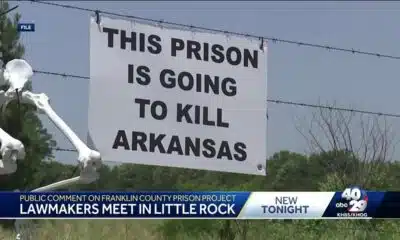Kaiser Health News
‘Everybody in This Community Has a Gun’: How Oakland Lost Its Grip on Gun Violence
Samantha Young
Tue, 28 Nov 2023 10:00:00 +0000
OAKLAND, Calif. — The red-tipped bullet pierces skin and melts into it, Javier Velasquez Lopez explains. The green-tipped bullet penetrates armored vests. And the hollow-tipped bullet expands as it tears through bodies.
At 19, Velasquez Lopez knows a lot about ammunition because many of his friends own guns, he said. They carry to defend themselves in East Oakland, where metal bars protect shop windows and churches stand behind tall, chain-link fences.
Some people even hide AR-15-style assault weapons down their pants legs, he said.
“It doesn’t feel safe. Wherever you’re at, you’re always anxious,” said Velasquez Lopez, who dreams of leaving the city where he was born. “You’re always wondering what’s going to happen.”
Last year, two gunmen in ski masks stormed his high school, killing a school district carpenter and injuring five other adults, including two students.
Oakland won acclaim just a few years ago as a national model for gun violence prevention, in part by bringing police and community groups together to target the small number of people suspected of driving the gun violence.
Then, in 2020, the covid-19 pandemic shut down schools, businesses, and critical social services nationwide, leaving many low-income people isolated and desperate — facing the loss of their jobs, homes, or both. The same year, police murdered George Floyd, a Black man in Minneapolis, which released pent-up fury over racial discrimination by law enforcement, education, and other institutions — sparking nationwide protests and calls to cut police funding.
In the midst of this racial reckoning and facing the threats of an unknown and deadly virus, Americans bought even more guns, forcing some cities, such as Raleigh, North Carolina; Chicago; New York City; and Oakland, to confront a new wave of violent crime.
“There was emotional damage. There was physical damage,” said James Jackson, CEO of Alameda Health System, whose Wilma Chan Highland Hospital Campus, a regional trauma center in Oakland, treated 502 gunshot victims last year, compared with 283 in 2019. “And I think some of this violence that we’re seeing is a manifestation of the damage that people experienced.”
Jackson is among a growing chorus of health experts who describe gun violence as a public health crisis that disproportionately affects Black and Hispanic residents in poor neighborhoods, the very people who disproportionately struggle with Type 2 diabetes and other preventable health conditions. Covid further eviscerated these communities, Jackson added.
While the pandemic has retreated, gun violence has not. Oaklanders, many of whom take pride in the ethnic diversity of their city, are overwhelmingly upset about the rise in violent crime — the shootings, thefts, and other street crimes. At town halls, City Council meetings, and protests, a broad cross-section of residents say they no longer feel safe.
Programs that worked a few years ago don’t seem to be making a dent now. City leaders are spending millions to hire more police officers and fund dozens of community initiatives, such as placing violence prevention teams at high schools to steer kids away from guns and crime.
Yet gun ownership in America is at a historic high, even in California, which gun control advocates say has the strictest gun laws in the country. More than 1 million Californians bought a gun during the first year of the pandemic, according to the latest data from the state attorney general.
As Alameda County District Attorney Pamela Price told an audience at a September town hall in East Oakland: “We are in a unique, crazy time where everybody in this community has a gun.”
The Streets of Oakland
Oakland’s flatlands southeast of downtown are the backdrop of most of the city’s shootings and murders.
The area stands in stark contrast to the extreme wealth of the millionaire homes that dot the Oakland Hills and the immaculate, flower-lined streets of downtown. The city’s revived waterfront, named after famed author and local hero Jack London, draws tourists to trendy restaurants.
On a Saturday night in August, Shawn Upshaw drove through the flatlands along International Boulevard, past the prostitutes who gather on nearly every corner for at least a mile, and into “hot spots,” where someone is shot nearly every weekend, he said.
“When I grew up, women and kids would get a pass. They wouldn’t get caught in the crossfire,” said Upshaw, 52, who was born and raised in Oakland. “But now women and kids get it, too.”
Upshaw works as a violence interrupter for the city’s Department of Violence Prevention, which coordinates with the police department and community organizations in a program called Ceasefire.
When there’s a shooting, the police department alerts Upshaw on his phone and he heads to the scene. He doesn’t wear a police uniform. He’s a civilian in street clothes: jeans and a black zip-up jacket. It makes him more approachable, he said, and he’s not there to place blame, but rather to offer help and services to survivors and bystanders.
The goal, he said, is to stop a retaliatory shooting by a rival gang or grieving family member.
Police also use crime data to approach people with gang affiliations or long criminal records who are likely to use a gun in a crime — or be shot. Community groups follow up with offers of job training, education, meals, and more.
“We tell them they’re on our radar and try to get them to recognize there are alternatives to street violence,” said Oakland Police Department Capt. Trevelyon Jones, head of Ceasefire. “We give them a safe way of backing out of a conflict while maintaining their street honor.”
Every Thursday at police headquarters, officers convene a “shooting review.” They team up with representatives from community groups to make house calls to victims and their relatives.
After the program launched in 2012, Oakland’s homicides plummeted and were down 39% in 2019, according to a report commissioned by the Oakland Police Department.
Then covid hit.
“You had primary care that became an issue. You had housing that became an issue. You had employment that became an issue,” said Maury Nation, an associate professor at Vanderbilt University. “It created a surplus of the people who fit that highest risk group, and that overwhelms something like Ceasefire.”
With ever-rising housing prices in Oakland and across California, homeless encampments have multiplied on sidewalks and under freeway bypasses. The city is also bracing for the loss of jobs and civic pride if the Oakland Athletics baseball team relocates after April 2024, following departures by the NBA’s Golden State Warriors in 2019 and the NFL’s Raiders in 2020.
“Housing, food insecurity, not having jobs that pay wages for folks, all can lead to violence and mental health issues,” said Sabrina Valadez-Rios, who works at the Freedom Community Clinic in Oakland and teaches a high school class for students who have experienced gun violence. Her father was fatally shot outside their Oakland home when she was a child. “We need to teach kids how to deal with trauma. Violence is not going to stop in Oakland.”
Shared with permission from The Trace.
Homicides in Oakland climbed to 123 people in 2021, police reports show, dipping slightly to 120 last year. Police have tallied 108 homicides as of Nov. 12 this year. Neither the police department nor the city provided statistics on how many of those killings involved firearms, despite repeated requests from KFF Health News.
Experts also blame the rise in killings in Oakland and other American cities on the prevalence of gun ownership in the U.S., which has more guns than people. For all the pandemic disruption worldwide, homicide rates didn’t go up in countries with strict gun laws, said Thomas Abt, director of the Center for the Study and Practice of Violence Reduction at the University of Maryland.
“We saw gun violence, homicides, shootings spike up all around the country. And interestingly, it did not happen internationally,” Abt said. “The pandemic did not lead to more violence in other nations.”
Unrest in Oakland
Oakland residents are angry. One by one, business owners, community organizers, church leaders, and teenagers have stood at town halls and City Council meetings this year with an alarming message: They no longer feel safe anywhere in their city — at any time.
“It’s not just a small number of people in the evening or nighttime. This is all hours, day and night,” said Noha Aboelata, founder of the Roots Community Health Center in Oakland. “Someone’s over here pushing a stroller and someone’s getting shot right next to them.”
One morning in early April, automatic gunfire erupted outside a Roots clinic. Patients and staff members dropped to the ground and took cover. After the shooting stopped, medical assistants and a doctor gave first aid to a man in his 20s who had been shot six times.
Everyone is blaming someone or something else for the bloodshed.
Business owners have had enough. In September, Target announced it would close nine stores in four states, including in Oakland because of organized retail theft; the famed Vietnamese restaurant Le Cheval shut its doors after 38 years, partly blaming car break-ins and other criminal activity for depressing its business; and more than 200 business owners staged an hours-long strike to protest the rise in crime.
The leadership of the local NAACP, the nation’s oldest civil rights organization, made headlines this summer when it said Oakland was seeing a “heyday” for criminals, and pointed to the area’s “failed leadership” and “movement to defund the police.”
“It feels like there’s a dark cloud over Oakland,” said Cynthia Adams, head of the local chapter, which has called on the city to hire 250 more police officers.
Price, a progressive elected last year, already faces a recall effort, in part because she rejects blanket enhanced sentences for gangs and weapons charges, and has declined to charge youths as adults.
The new mayor, Sheng Thao, was criticized for firing the police chief for misconduct and breaking a campaign promise to double funding at the city’s Department of Violence Prevention. In her first State of the City address last month, Thao described the surge in crime as “totally and completely unacceptable,” and acknowledged that Oaklanders are hurting and scared. She said the city has expanded police foot patrols and funded six new police academies, as well as boosted funding for violence prevention and affordable housing.
“Not a day goes by where I don’t wish I could just wave a magic wand and silence the gunfire,” Thao said.
Many in the community, including Valadez-Rios, advocate for broader investment in Oakland’s poorest neighborhoods over more law enforcement.
City councils, states, and the federal government are putting their faith in violence prevention programs, in some cases bankrolling them from nontraditional sources, such as the state-federal Medicaid health insurance program for low-income people.
Last month, California’s Democratic Gov. Gavin Newsom approved an 11% state tax on guns and ammunition, and $75 million of the revenue annually is expected to go to violence prevention programs.
Although these programs are growing in popularity, it is unclear how successful they are. In some cases, proven programs that involve law enforcement, such as Ceasefire, were cut back or shelved after George Floyd was murdered, said Abt, the Maryland researcher.
“The intense opposition to law enforcement means that the city was unwilling to use a portion of the tools that have been proven,” Abt said. “It’s good to work on preventing youth violence, but the vast majority of serious violence is perpetrated by adults.”
Not a day goes by where I don’t wish I could just wave a magic wand and silence the gunfire.
Oakland Mayor Sheng Thao
A Focus on Schools
Kentrell Killens, interim chief at the Oakland Department of Violence Prevention, acknowledges that young adults drive Oakland’s gun violence, not high school kids. But, he said, shootings on the streets affect children. Of the 171 homicides in 2019 and 2020, 4% of victims were 17 or under, while 59% were ages 18 to 34, according to the Oakland Police Department.
The number of children injured in nonfatal shootings is also worrisome, he said. Roughly 6% of victims and 14% of suspects in nonfatal shootings were 17 or younger in 2019 and 2020.
“We’ve seen the impact of violence on young people and how they have to make decisions around what roles they want to play,” said Killens, who spent a decade as a case manager working with schoolkids.
By being in the schools, “we can deal with the conflicts” that could spill into the community, he added.
At Fremont High School, Principal Nidya Baez has welcomed a three-person team to her campus to confront gun violence. One caseworker focuses on gun violence and another on sexual assaults and healthy relationships. The third is a social worker who connects students and their families to services.
They are part of a $2 million city pilot program created after the Oakland School Board eliminated school-based police in 2020 — about one month after George Floyd was killed and after a nine-year push by community activists to kick police out of schools.
“We’ve been at a lot of funerals, unfortunately, for gang-related stuff or targeting of kids, wrong-place-wrong-time kind of thing,” said Baez, whose father was shot and injured on his ice cream truck when she was a child.
When Francisco “Cisco” Cisneros, a violence interrupter from the nonprofit group Communities United for Restorative Youth Justice, arrived at Fremont in January, students were wary, he said. Many still are. Students are hard-wired not to share information — not to be a “snitch” — or open up about themselves or their home life, especially to an adult, Cisneros said. And they don’t want to talk to fellow students from another network, group, or gang.
“If we catch them at an early age, right now, we can change that mindset,” said Cisneros, who was born and raised in Oakland.
Cisneros pulls from his past to build a rapport with students. This summer, for example, when he overheard a student chatting on the phone to an uncle in jail, Cisneros asked about him. It turns out Cisneros and the boy’s uncle had grown up in the same neighborhood.
That was enough to begin a relationship between Cisneros and the student, “J,” who declined to be identified by his full name for fear of retribution. The 16-year-old credits Cisneros, whom he describes as “like a dad,” with keeping him engaged in school and employed with summer jobs — away from trouble. Still, he regularly worries about making a wrong move.
“You could do one thing and you could end up in a situation where your life is at risk,” J said in Cisneros’ office. “You go from being in school one day to being in a very bad, sticky situation.”
The program is underway in seven high schools, and Cisneros believes he has helped prevent a handful of conflicts from escalating into gun violence.
A Better Life
After his school counselor was shot at Rudsdale High School in September 2022, Velasquez Lopez heard that the man and other victims were treated at nearby Highland Hospital.
“Seeing him get hurt, he obviously needed medical attention,” Velasquez Lopez said. “That made it obvious I could help my community if I were to be a nurse to help people that live around my area.”
When a recruiter from the Alameda Health System came to campus to promote a six-week internship at Highland Hospital, Velasquez Lopez applied. It was, he said, a dramatic step for a student who had never cared about school or sought vocational training.
Over the summer, he volunteered in the emergency room, learned how to take a patient’s vitals, watched blood transfusions, and translated for Spanish-speaking patients.
Velasquez Lopez, who graduated this year, is now looking for ways to get a nursing degree. The cost of college is out of reach at the moment, but he knows he doesn’t want to stay in a city where you can easily buy a gun for $1,000 — or half that, if it’s been used in a crime.
Velasquez Lopez said he has bigger goals for himself.
Young people in East Oakland “always feel like we’re trapped in that community, and we can’t get out,” he said. “But I feel like we still have a chance to change our lives.”
This article was produced by KFF Health News, which publishes California Healthline, an editorially independent service of the California Health Care Foundation.
——————————
By: Samantha Young
Title: ‘Everybody in This Community Has a Gun’: How Oakland Lost Its Grip on Gun Violence
Sourced From: kffhealthnews.org/news/article/gun-violence-oakland-shootings-interrupters-crime/
Published Date: Tue, 28 Nov 2023 10:00:00 +0000
Kaiser Health News
How To Find the Right Medical Rehab Services
Rehabilitation therapy can be a godsend after hospitalization for a stroke, a fall, an accident, a joint replacement, a severe burn, or a spinal cord injury, among other conditions. Physical, occupational, and speech therapy are offered in a variety of settings, including at hospitals, nursing homes, clinics, and at home. It’s crucial to identify a high-quality, safe option with professionals experienced in treating your condition.
What kinds of rehab therapy might I need?
Physical therapy helps patients improve their strength, stability, and movement and reduce pain, usually through targeted exercises. Some physical therapists specialize in neurological, cardiovascular, or orthopedic issues. There are also geriatric and pediatric specialists. Occupational therapy focuses on specific activities (referred to as “occupations”), often ones that require fine motor skills, like brushing teeth, cutting food with a knife, and getting dressed. Speech and language therapy help people communicate. Some patients may need respiratory therapy if they have trouble breathing or need to be weaned from a ventilator.
Will insurance cover rehab?
Medicare, health insurers, workers’ compensation, and Medicaid plans in some states cover rehab therapy, but plans may refuse to pay for certain settings and may limit the amount of therapy you receive. Some insurers may require preauthorization, and some may terminate coverage if you’re not improving. Private insurers often place annual limits on outpatient therapy. Traditional Medicare is generally the least restrictive, while private Medicare Advantage plans may monitor progress closely and limit where patients can obtain therapy.
Should I seek inpatient rehabilitation?
Patients who still need nursing or a doctor’s care but can tolerate three hours of therapy five days a week may qualify for admission to a specialized rehab hospital or to a unit within a general hospital. Patients usually need at least two of the main types of rehab therapy: physical, occupational, or speech. Stays average around 12 days.
How do I choose?
Look for a place that is skilled in treating people with your diagnosis; many inpatient hospitals list specialties on their websites. People with complex or severe medical conditions may want a rehab hospital connected to an academic medical center at the vanguard of new treatments, even if it’s a plane ride away.
“You’ll see youngish patients with these life-changing, fairly catastrophic injuries,” like spinal cord damage, travel to another state for treatment, said Cheri Blauwet, chief medical officer of Spaulding Rehabilitation in Boston, one of 15 hospitals the federal government has praised for cutting-edge work.
But there are advantages in selecting a hospital close to family and friends who can help after you are discharged. Therapists can help train at-home caregivers.
How do I find rehab hospitals?
The discharge planner or caseworker at the acute care hospital should provide options. You can search for inpatient rehabilitation facilities by location or name through Medicare’s Care Compare website. There you can see how many patients the rehab hospital has treated with your condition — the more the better. You can search by specialty through the American Medical Rehabilitation Providers Association, a trade group that lists its members.
Find out what specialized technologies a hospital has, like driving simulators — a car or truck that enable a patient to practice getting in and out of a vehicle — or a kitchen table with utensils to practice making a meal.
How can I be confident a rehab hospital is reliable?
It’s not easy: Medicare doesn’t analyze staffing levels or post on its website results of safety inspections as it does for nursing homes. You can ask your state public health agency or the hospital to provide inspection reports for the last three years. Such reports can be technical, but you should get the gist. If the report says an “immediate jeopardy” was called, that means inspectors identified safety problems that put patients in danger.
The rate of patients readmitted to a general hospital for a potentially preventable reason is a key safety measure. Overall, for-profit rehabs have higher readmission rates than nonprofits do, but there are some with lower readmission rates and some with higher ones. You may not have a nearby choice: There are fewer than 400 rehab hospitals, and most general hospitals don’t have a rehab unit.
You can find a hospital’s readmission rates under Care Compare’s quality section. Rates lower than the national average are better.
Another measure of quality is how often patients are functional enough to go home after finishing rehab rather than to a nursing home, hospital, or health care institution. That measure is called “discharge to community” and is listed under Care Compare’s quality section. Rates higher than the national average are better.
Look for reviews of the hospital on Yelp and other sites. Ask if the patient will see the same therapist most days or a rotating cast of characters. Ask if the therapists have board certifications earned after intensive training to treat a patient’s particular condition.
Visit if possible, and don’t look only at the rooms in the hospital where therapy exercises take place. Injuries often occur in the 21 hours when a patient is not in therapy, but in his or her room or another part of the building. Infections, falls, bedsores, and medication errors are risks. If possible, observe whether nurses promptly respond to call lights, seem overloaded with too many patients, or are apathetically playing on their phones. Ask current patients and their family members if they are satisfied with the care.
What if I can’t handle three hours of therapy a day?
A nursing home that provides rehab might be appropriate for patients who don’t need the supervision of a doctor but aren’t ready to go home. The facilities generally provide round-the-clock nursing care. The amount of rehab varies based on the patient. There are more than 14,500 skilled nursing facilities in the United States, 12 times as many as hospitals offering rehab, so a nursing home may be the only option near you.
You can look for them through Medicare’s Care Compare website. (Read our previous guide to finding a good, well-staffed home to know how to assess the overall staffing.)
What if patients are too frail even for a nursing home?
They might need a long-term care hospital. Those specialize in patients who are in comas, on ventilators, and have acute medical conditions that require the presence of a physician. Patients stay at least four weeks, and some are there for months. Care Compare helps you search. There are fewer than 350 such hospitals.
I’m strong enough to go home. How do I receive therapy?
Many rehab hospitals offer outpatient therapy. You also can go to a clinic, or a therapist can come to you. You can hire a home health agency or find a therapist who takes your insurance and makes house calls. Your doctor or hospital may give you referrals. On Care Compare, home health agencies list whether they offer physical, occupational, or speech therapy. You can search for board-certified therapists on the American Physical Therapy Association’s website.
While undergoing rehab, patients sometimes move from hospital to nursing facility to home, often at the insistence of their insurers. Alice Bell, a senior specialist at the APTA, said patients should try to limit the number of transitions, for their own safety.
“Every time a patient moves from one setting to another,” she said, “they’re in a higher risk zone.”
KFF Health News is a national newsroom that produces in-depth journalism about health issues and is one of the core operating programs at KFF—an independent source of health policy research, polling, and journalism. Learn more about KFF.
USE OUR CONTENT
This story can be republished for free (details).
KFF Health News is a national newsroom that produces in-depth journalism about health issues and is one of the core operating programs at KFF—an independent source of health policy research, polling, and journalism. Learn more about KFF.
Subscribe to KFF Health News’ free Morning Briefing.
This article first appeared on KFF Health News and is republished here under a Creative Commons license.
The post How To Find the Right Medical Rehab Services appeared first on kffhealthnews.org
Note: The following A.I. based commentary is not part of the original article, reproduced above, but is offered in the hopes that it will promote greater media literacy and critical thinking, by making any potential bias more visible to the reader –Staff Editor.
Political Bias Rating: Centrist
This article from KFF Health News provides a comprehensive, fact-based guide to rehabilitation therapy options and how to navigate insurance, care settings, and provider quality. It avoids ideological framing and presents information in a neutral, practical tone aimed at helping consumers make informed medical decisions. While it touches on Medicare and private insurance policies, it does so without political commentary or value judgments, and no partisan viewpoints or advocacy positions are evident. The focus remains on patient care, safety, and informed choice, supporting a nonpartisan, service-oriented approach to health reporting.
Kaiser Health News
States Brace for Reversal of Obamacare Coverage Gains Under Trump’s Budget Bill
Shorter enrollment periods. More paperwork. Higher premiums. The sweeping tax and spending bill pushed by President Donald Trump includes provisions that would not only reshape people’s experience with the Affordable Care Act but, according to some policy analysts, also sharply undermine the gains in health insurance coverage associated with it.
The moves affect consumers and have particular resonance for the 19 states (plus Washington, D.C.) that run their own ACA exchanges.
Many of those states fear that the additional red tape — especially requirements that would end automatic reenrollment — would have an outsize impact on their policyholders. That’s because a greater percentage of people in those states use those rollovers versus shopping around each year, which is more commonly done by people in states that use the federal healthcare.gov marketplace.
“The federal marketplace always had a message of, ‘Come back in and shop,’ while the state-based markets, on average, have a message of, ‘Hey, here’s what you’re going to have next year, here’s what it will cost; if you like it, you don’t have to do anything,’” said Ellen Montz, who oversaw the federal ACA marketplace under the Biden administration as deputy administrator and director at the Center for Consumer Information and Insurance Oversight. She is now a managing director with the Manatt Health consulting group.
Millions — perhaps up to half of enrollees in some states — may lose or drop coverage as a result of that and other changes in the legislation combined with a new rule from the Trump administration and the likely expiration at year’s end of enhanced premium subsidies put in place during the covid-19 pandemic. Without an extension of those subsidies, which have been an important driver of Obamacare enrollment in recent years, premiums are expected to rise 75% on average next year. That’s starting to happen already, based on some early state rate requests for next year, which are hitting double digits.
“We estimate a minimum 30% enrollment loss, and, in the worst-case scenario, a 50% loss,” said Devon Trolley, executive director of Pennie, the ACA marketplace in Pennsylvania, which had 496,661 enrollees this year, a record.
Drops of that magnitude nationally, coupled with the expected loss of Medicaid coverage for millions more people under the legislation Trump calls the “One Big Beautiful Bill,” could undo inroads made in the nation’s uninsured rate, which dropped by about half from the time most of the ACA’s provisions went into effect in 2014, when it hovered around 14% to 15% of the population, to just over 8%, according to the most recent data.
Premiums would rise along with the uninsured rate, because older or sicker policyholders are more likely to try to jump enrollment hurdles, while those who rarely use coverage — and are thus less expensive — would not.
After a dramatic all-night session, House Republicans passed the bill, meeting the president’s July 4 deadline. Trump is expected to sign the measure on Independence Day. It would increase the federal deficit by trillions of dollars and cut spending on a variety of programs, including Medicaid and nutrition assistance, to partly offset the cost of extending tax cuts put in place during the first Trump administration.
The administration and its supporters say the GOP-backed changes to the ACA are needed to combat fraud. Democrats and ACA supporters see this effort as the latest in a long history of Republican efforts to weaken or repeal Obamacare. Among other things, the legislation would end several changes put in place by the Biden administration that were credited with making it easier to sign up, such as lengthening the annual open enrollment period and launching a special program for very low-income people that essentially allows them to sign up year-round.
In addition, automatic reenrollment, used by more than 10 million people for 2025 ACA coverage, would end in the 2028 sign-up season. Instead, consumers would have to update their information, starting in August each year, before the close of open enrollment, which would end Dec. 15, a month earlier than currently.
That’s a key change to combat rising enrollment fraud, said Brian Blase, president of the conservative Paragon Health Institute, because it gets at what he calls the Biden era’s “lax verification requirements.”
He blames automatic reenrollment, coupled with the availability of zero-premium plans for people with lower incomes that qualify them for large subsidies, for a sharp uptick in complaints from insurers, consumers, and brokers about fraudulent enrollments in 2023 and 2024. Those complaints centered on consumers’ being enrolled in an ACA plan, or switched from one to another, without authorization, often by commission-seeking brokers.
In testimony to Congress on June 25, Blase wrote that “this simple step will close a massive loophole and significantly reduce improper enrollment and spending.”
States that run their own marketplaces, however, saw few, if any, such problems, which were confined mainly to the 31 states using the federal healthcare.gov.
The state-run marketplaces credit their additional security measures and tighter control over broker access than healthcare.gov for the relative lack of problems.
“If you look at California and the other states that have expanded their Medicaid programs, you don’t see that kind of fraud problem,” said Jessica Altman, executive director of Covered California, the state’s Obamacare marketplace. “I don’t have a single case of a consumer calling Covered California saying, ‘I was enrolled without consent.’”
Such rollovers are common with other forms of health insurance, such as job-based coverage.
“By requiring everyone to come back in and provide additional information, and the fact that they can’t get a tax credit until they take this step, it is essentially making marketplace coverage the most difficult coverage to enroll in,” said Trolley at Pennie, 65% of whose policyholders were automatically reenrolled this year, according to KFF data. KFF is a health information nonprofit that includes KFF Health News.
Federal data shows about 22% of federal sign-ups in 2024 were automatic-reenrollments, versus 58% in state-based plans. Besides Pennsylvania, the states that saw such sign-ups for more than 60% of enrollees include California, New York, Georgia, New Jersey, and Virginia, according to KFF.
States do check income and other eligibility information for all enrollees — including those being automatically renewed, those signing up for the first time, and those enrolling outside the normal open enrollment period because they’ve experienced a loss of coverage or other life event or meet the rules for the low-income enrollment period.
“We have access to many data sources on the back end that we ping, to make sure nothing has changed. Most people sail through and are able to stay covered without taking any proactive step,” Altman said.
If flagged for mismatched data, applicants are asked for additional information. Under current law, “we have 90 days for them to have a tax credit while they submit paperwork,” Altman said.
That would change under the tax and spending plan before Congress, ending presumptive eligibility while a person submits the information.
A white paper written for Capital Policy Analytics, a Washington-based consultancy that specializes in economic analysis, concluded there appears to be little upside to the changes.
While “tighter verification can curb improper enrollments,” the additional paperwork, along with the expiration of higher premiums from the enhanced tax subsidies, “would push four to six million eligible people out of Marketplace plans, trading limited fraud savings for a surge in uninsurance,” wrote free market economists Ike Brannon and Anthony LoSasso.
“Insurers would be left with a smaller, sicker risk pool and heightened pricing uncertainty, making further premium increases and selective market exits [by insurers] likely,” they wrote.
KFF Health News is a national newsroom that produces in-depth journalism about health issues and is one of the core operating programs at KFF—an independent source of health policy research, polling, and journalism. Learn more about KFF.
USE OUR CONTENT
This story can be republished for free (details).
KFF Health News is a national newsroom that produces in-depth journalism about health issues and is one of the core operating programs at KFF—an independent source of health policy research, polling, and journalism. Learn more about KFF.
Subscribe to KFF Health News’ free Morning Briefing.
This article first appeared on KFF Health News and is republished here under a Creative Commons license.
The post States Brace for Reversal of Obamacare Coverage Gains Under Trump’s Budget Bill appeared first on kffhealthnews.org
Note: The following A.I. based commentary is not part of the original article, reproduced above, but is offered in the hopes that it will promote greater media literacy and critical thinking, by making any potential bias more visible to the reader –Staff Editor.
Political Bias Rating: Center-Left
This content presents a critique of Republican-led changes to the Affordable Care Act, emphasizing potential negative impacts such as increased premiums, reduced enrollment, and the erosion of coverage gains made under the ACA. It highlights the perspective of policy analysts and state officials who express concern over these measures, while also presenting conservative viewpoints, particularly those focusing on fraud reduction. Overall, the tone and framing lean toward protecting the ACA and its expansions, which traditionally aligns with Center-Left media analysis.
Kaiser Health News
Dual Threats From Trump and GOP Imperil Nursing Homes and Their Foreign-Born Workers
In a top-rated nursing home in Alexandria, Virginia, the Rev. Donald Goodness is cared for by nurses and aides from various parts of Africa. One of them, Jackline Conteh, a naturalized citizen and nurse assistant from Sierra Leone, bathes and helps dress him most days and vigilantly intercepts any meal headed his way that contains gluten, as Goodness has celiac disease.
“We are full of people who come from other countries,” Goodness, 92, said about Goodwin House Alexandria’s staff. Without them, the retired Episcopal priest said, “I would be, and my building would be, desolate.”
The long-term health care industry is facing a double whammy from President Donald Trump’s crackdown on immigrants and the GOP’s proposals to reduce Medicaid spending. The industry is highly dependent on foreign workers: More than 800,000 immigrants and naturalized citizens comprise 28% of direct care employees at home care agencies, nursing homes, assisted living facilities, and other long-term care companies.
But in January, the Trump administration rescinded former President Joe Biden’s 2021 policy that protected health care facilities from Immigration and Customs Enforcement raids. The administration’s broad immigration crackdown threatens to drastically reduce the number of current and future workers for the industry. “People may be here on a green card, and they are afraid ICE is going to show up,” said Katie Smith Sloan, president of LeadingAge, an association of nonprofits that care for older adults.
Existing staffing shortages and quality-of-care problems would be compounded by other policies pushed by Trump and the Republican-led Congress, according to nursing home officials, resident advocates, and academic experts. Federal spending cuts under negotiation may strip nursing homes of some of their largest revenue sources by limiting ways states leverage Medicaid money and making it harder for new nursing home residents to retroactively qualify for Medicaid. Care for 6 in 10 residents is paid for by Medicaid, the state-federal health program for poor or disabled Americans.
“We are facing the collision of two policies here that could further erode staffing in nursing homes and present health outcome challenges,” said Eric Roberts, an associate professor of internal medicine at the University of Pennsylvania.
The industry hasn’t recovered from covid-19, which killed more than 200,000 long-term care facility residents and workers and led to massive staff attrition and turnover. Nursing homes have struggled to replace licensed nurses, who can find better-paying jobs at hospitals and doctors’ offices, as well as nursing assistants, who can earn more working at big-box stores or fast-food joints. Quality issues that preceded the pandemic have expanded: The percentage of nursing homes that federal health inspectors cited for putting residents in jeopardy of immediate harm or death has risen alarmingly from 17% in 2015 to 28% in 2024.
In addition to seeking to reduce Medicaid spending, congressional Republicans have proposed shelving the biggest nursing home reform in decades: a Biden-era rule mandating minimum staffing levels that would require most of the nation’s nearly 15,000 nursing homes to hire more workers.
The long-term care industry expects demand for direct care workers to burgeon with an influx of aging baby boomers needing professional care. The Census Bureau has projected the number of people 65 and older would grow from 63 million this year to 82 million in 2050.
In an email, Vianca Rodriguez Feliciano, a spokesperson for the Department of Health and Human Services, said the agency “is committed to supporting a strong, stable long-term care workforce” and “continues to work with states and providers to ensure quality care for older adults and individuals with disabilities.” In a separate email, Tricia McLaughlin, a Department of Homeland Security spokesperson, said foreigners wanting to work as caregivers “need to do that by coming here the legal way” but did not address the effect on the long-term care workforce of deportations of classes of authorized immigrants.
Goodwin Living, a faith-based nonprofit, runs three retirement communities in northern Virginia for people who live independently, need a little assistance each day, have memory issues, or require the availability of around-the-clock nurses. It also operates a retirement community in Washington, D.C. Medicare rates Goodwin House Alexandria as one of the best-staffed nursing homes in the country. Forty percent of the organization’s 1,450 employees are foreign-born and are either seeking citizenship or are already naturalized, according to Lindsay Hutter, a Goodwin spokesperson.
“As an employer, we see they stay on with us, they have longer tenure, they are more committed to the organization,” said Rob Liebreich, Goodwin’s president and CEO.
Jackline Conteh spent much of her youth shuttling between Sierra Leone, Liberia, and Ghana to avoid wars and tribal conflicts. Her mother was killed by a stray bullet in her home country of Liberia, Conteh said. “She was sitting outside,” Conteh, 56, recalled in an interview.
Conteh was working as a nurse in a hospital in Sierra Leone in 2009 when she learned of a lottery for visas to come to the United States. She won, though she couldn’t afford to bring her husband and two children along at the time. After she got a nursing assistant certification, Goodwin hired her in 2012.
Conteh said taking care of elders is embedded in the culture of African families. When she was 9, she helped feed and dress her grandmother, a job that rotated among her and her sisters. She washed her father when he was dying of prostate cancer. Her husband joined her in the United States in 2017; she cares for him because he has heart failure.
“Nearly every one of us from Africa, we know how to care for older adults,” she said.
Her daughter is now in the United States, while her son is still in Africa. Conteh said she sends money to him, her mother-in-law, and one of her sisters.
In the nursing home where Goodness and 89 other residents live, Conteh helps with daily tasks like dressing and eating, checks residents’ skin for signs of swelling or sores, and tries to help them avoid falling or getting disoriented. Of 102 employees in the building, broken up into eight residential wings called “small houses” and a wing for memory care, at least 72 were born abroad, Hutter said.
Donald Goodness grew up in Rochester, New York, and spent 25 years as rector of The Church of the Ascension in New York City, retiring in 1997. He and his late wife moved to Alexandria to be closer to their daughter, and in 2011 they moved into independent living at the Goodwin House. In 2023 he moved into one of the skilled nursing small houses, where Conteh started caring for him.
“I have a bad leg and I can’t stand on it very much, or I’d fall over,” he said. “She’s in there at 7:30 in the morning, and she helps me bathe.” Goodness said Conteh is exacting about cleanliness and will tell the housekeepers if his room is not kept properly.
Conteh said Goodness was withdrawn when he first arrived. “He don’t want to come out, he want to eat in his room,” she said. “He don’t want to be with the other people in the dining room, so I start making friends with him.”
She showed him a photo of Sierra Leone on her phone and told him of the weather there. He told her about his work at the church and how his wife did laundry for the choir. The breakthrough, she said, came one day when he agreed to lunch with her in the dining room. Long out of his shell, Goodness now sits on the community’s resident council and enjoys distributing the mail to other residents on his floor.
“The people that work in my building become so important to us,” Goodness said.
While Trump’s 2024 election campaign focused on foreigners here without authorization, his administration has broadened to target those legally here, including refugees who fled countries beset by wars or natural disasters. This month, the Department of Homeland Security revoked the work permits for migrants and refugees from Cuba, Haiti, Nicaragua, and Venezuela who arrived under a Biden-era program.
“I’ve just spent my morning firing good, honest people because the federal government told us that we had to,” Rachel Blumberg, president of the Toby & Leon Cooperman Sinai Residences of Boca Raton, a Florida retirement community, said in a video posted on LinkedIn. “I am so sick of people saying that we are deporting people because they are criminals. Let me tell you, they are not all criminals.”
At Goodwin House, Conteh is fearful for her fellow immigrants. Foreign workers at Goodwin rarely talk about their backgrounds. “They’re scared,” she said. “Nobody trusts anybody.” Her neighbors in her apartment complex fled the U.S. in December and returned to Sierra Leone after Trump won the election, leaving their children with relatives.
“If all these people leave the United States, they go back to Africa or to their various countries, what will become of our residents?” Conteh asked. “What will become of our old people that we’re taking care of?”
KFF Health News is a national newsroom that produces in-depth journalism about health issues and is one of the core operating programs at KFF—an independent source of health policy research, polling, and journalism. Learn more about KFF.
Subscribe to KFF Health News’ free Morning Briefing.
This article first appeared on KFF Health News and is republished here under a Creative Commons license.
The post Dual Threats From Trump and GOP Imperil Nursing Homes and Their Foreign-Born Workers appeared first on kffhealthnews.org
Note: The following A.I. based commentary is not part of the original article, reproduced above, but is offered in the hopes that it will promote greater media literacy and critical thinking, by making any potential bias more visible to the reader –Staff Editor.
Political Bias Rating: Center-Left
This content primarily highlights concerns about the impact of restrictive immigration policies and Medicaid spending cuts proposed by the Trump administration and Republican lawmakers on the long-term care industry. It emphasizes the importance of immigrant workers in healthcare, the challenges that staffing shortages pose to patient care, and the potential negative effects of GOP policy proposals. The tone is critical of these policies while sympathetic toward immigrant workers and advocates for maintaining or increasing government support for healthcare funding. The framing aligns with a center-left perspective, focusing on social welfare, immigrant rights, and concern about the consequences of conservative economic and immigration policies without descending into partisan rhetoric.
-
News from the South - Alabama News Feed7 days ago
Alabama lawmaker revives bill to allow chaplains in public schools
-
News from the South - Missouri News Feed7 days ago
Pulaski County town faces scrutiny after fatal overdose
-
News from the South - Arkansas News Feed7 days ago
Arkansas’s morning headlines | Sept. 9, 2025
-
News from the South - Texas News Feed7 days ago
‘Resilience and hope’ in Galveston: 125 years after greatest storm in US history | Texas
-
News from the South - Arkansas News Feed6 days ago
Group in lawsuit say Franklin county prison land was bought before it was inspected
-
News from the South - Kentucky News Feed5 days ago
Lexington man accused of carjacking, firing gun during police chase faces federal firearm charge
-
Mississippi News Video7 days ago
2025 Mississippi Book Festival announces sponsorship
-
The Center Square6 days ago
California mother says daughter killed herself after being transitioned by school | California














































